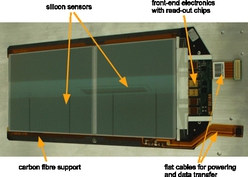Fig. 1: Picture of the CMS Detector
Phase 2 Outer Tracker
CMS Tracker End Caps
Compact Muon Solenoid Experiment
CMS Tracker End Caps
The CMS experiment has an all-silicon tracker as its central detection system that provides information on charged particle trajectories. Figure 1 to the right shows a drawing of the CMS detector. The arrow points to the interaction point (IP) at which the two LHC beams collide. The current tracker surrounds the IP with full coverage around the beam axes and coverage of up to 2.5 in pseudorapidity.
The CMS tracker consists of 15148 detector modules arranged in a so-called barrel and end cap configuration. A sketch of the detector layout is shown in the figure to the left. The red and blue lines indicate the position and orientation of the detector modules in the r-z plane where r is the distance to the beam axes and z is the distance to the IP along the beam axes.
The image below shows one of the current tracker end cap modules. Two sensors are mounted side-by-side and connected via bond wires. The effective strip length is about 20cm. The signals are read-out at one end by front-end electronics with dedicated read-out ASIC (Application Specific Integrated Circuits). The sensors and the electronics are supported by carbon fibre structures.
The LHC is ultimately expected to operate at L = 10^34 cm-2 s−1 and the CMS detector has been designed to cope with the high radiation and event rates expected at this luminosity. However, after several years of running, there will be strong motivation to increase the performance of the machine in order to expand the physics potential of the LHC. Thus, an upgrade of the machine to L = 5x10^34 cm-2 s−1, the High-Luminosity LHC (HL-LHC), is currently under study [1,2].
At this luminosity, the CMS tracker will have to deal with about 200 collisions per 25 ns, producing about 1200 charged tracks per unit of pseudo rapidity. This imposes demands on the silicon strip sensors and electronics which they were not designed to fulfill in terms of occupancy, readout capabilities and radiation hardness. In addition, key elements of the current detector will not survive more than a few years at full LHC intensity. At the time of the envisaged HL-LHC upgrade, the silicon strip modules of the current CMS tracker will already suffer from substantial radiation damage. Therefore, the CMS silicon tracker will have to be completely rebuilt. In addition, the current trigger system of CMS will not be able to handle the increased event rate and therefore the new tracker has to provide information for the first level trigger decision.
In order to achieve this, each module will be a sandwich of two silicon sensors that are read-out by the same electronics. The signals from both sensors will be correlated already on the module which allows for a measurement of the transverse momentum (pT) and can be used to trigger events with high pT tracks. This is shown in the figure above. Due to the strong magnetic field of the CMS solenoid, the bending of low momentum tracks is sufficiently large in order for the track to fall out of the search window that is opened by a signal on the bottom sensor.
The CMS HL-LHC tracker group at DESY investigates new design ideas for silicon strip detector modules for the future CMS tracker. The development of these modules, feasible for operating under HL-LHC conditions, holds several challenges, such as providing efficient cooling and keeping the silicon sensors and front-end electronics at low temperatures in order to ensure their radiation hardness, achieving high mechanical stability of the multi-material compound modules under temperature variations, and strongly reducing the material budget compared to the current module design.


